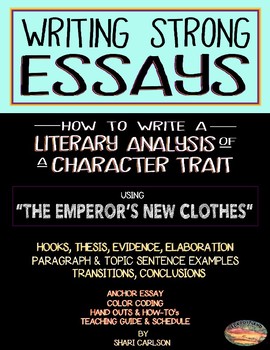ESSAYS: How to Write Them: A Literary Analysis of a Character Trait
ELA Portland - Shari Carlson
153 Followers
Grade Levels
4th - 10th, Higher Education, Homeschool
Resource Type
Standards
CCSSRL.5.1
CCSSRL.5.4
CCSSRL.6.1
CCSSRL.6.4
CCSSRI.5.1
Formats Included
- PDF
Pages
70 pages
ELA Portland - Shari Carlson
153 Followers
Description
Your complete guide for writing essays and paragraphs.
This writing resource has 70 pages of examples, handouts, and how-tos for:
- thesis statements
- topic sentences
- hooks
- evidence
- elaboration/analysis
- transitions
- conclusions
This is a how-to for writing stand-alone paragraphs and complete essays for students in grades 5–10.
It also includes:
- TBEAR definitions, breakdown, and color coding
- teaching timeline
- anchor essay and text for the story, "The Emperor and His New Clothes."
- frames for new concepts
Understand how to teach the parts of an essay in a new way.
Related Materials: HOW TO WRITE INFORMATIONAL ESSAYS USING ARTICLES, “MAGNIFICENT MANTA” & “THE LIFE IN ANTARCTICA”
Total Pages
70 pages
Answer Key
N/A
Teaching Duration
N/A
Report this resource to TPT
Reported resources will be reviewed by our team. Report this resource to let us know if this resource violates TPT’s content guidelines.
Standards
to see state-specific standards (only available in the US).
CCSSRL.5.1
Quote accurately from a text when explaining what the text says explicitly and when drawing inferences from the text.
CCSSRL.5.4
Determine the meaning of words and phrases as they are used in a text, including figurative language such as metaphors and similes.
CCSSRL.6.1
Cite textual evidence to support analysis of what the text says explicitly as well as inferences drawn from the text.
CCSSRL.6.4
Determine the meaning of words and phrases as they are used in a text, including figurative and connotative meanings; analyze the impact of a specific word choice on meaning and tone.
CCSSRI.5.1
Quote accurately from a text when explaining what the text says explicitly and when drawing inferences from the text.





